
West Virginia, along with much of the Mid-Atlantic, experienced one of the rainiest springs on record. By early June, it became clear to organizers of the 24 Hours of Snowshoe mountain bike race that a dry course would be unlikely.
Moist conditions had plagued the event for several years, with muddy sections of the course scaring away some participants even as it attracted others searching for the ultimate challenge. West Virginia-based Granny Gear Productions, which organizes the annual event, had taken steps in recent years to shore up particularly fragile parts of the course, such as adding 60 tons of crushed stone to armor up sections of the trail.
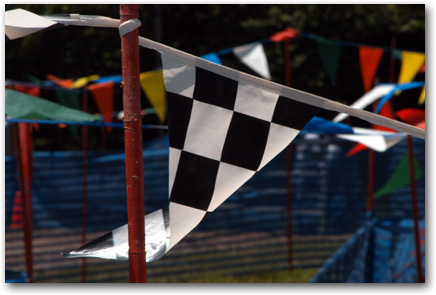
|
|
|
On Friday, June 27, 2003 - the day before the race began - light rain once again fell on West Virginia’s Snowshoe Mountain Resort, the venue for the event. Reluctantly, race organizers decided to cut out several small legs of the course that were prone to muddy conditions: Black Run Road Climb, Enchanted Forest, Dark Side of the Moon, and Aheadset Adjustment. This left 7 miles of challenging course, including steep singletrack climbs and twisty descents through unyielding trees.
On Saturday morning, a bright sun greeted race participants, and concerns about the weather quickly evaporated into excitement and adrenaline over the race.
The 24 Hours of Snowshoe race is one of the toughest mountain bike endurance races in the world. Held annually since 1992 (when it was located at Canaan Valley; it moved to Snowshoe in 2000), the event draws racers from across the country to tackle both physical and mental challenges as they race in different classes, in teams or solo, around the clock.
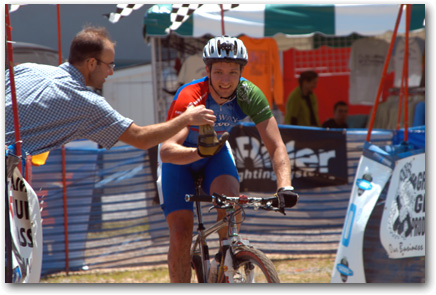
|
|
|
Granny Gear Productions sponsors similar 24-hour races in Moab, UT; Tahoe, CA; and the recently-added Temecula, CA, but Snowshoe is known as the most challenging of the bunch.
And perhaps too challenging for many participants: this year, 179 teams registered for the race. Last year, 358 teams participated, and the year before that, 543. Although the downward trend can be blamed partly on the economy, in a communiqué to participants shortly before the race began, Granny Gear Productions also pointed to the rideability of the course as a possible factor.
Although the course may have scared away some, for the 179 teams that showed up at Snowshoe on Saturday morning, there wasn’t a trace of negativity in the air. Racers and spectators were pumped and eager to start the race. The atmosphere seemed more intimate and relaxed than last year; the smaller number of teams also made the trail less crowded.
Snowshoe Mountain Resort offers plenty of lodging options, but the area around the Silver Creek Lodge turns into a small city of tents as many racers choose to camp out. The race is headquartered at Silver Creek; the course climbs briefly up a ski slope before heading down through the trees and darting off along a fire road. Eventually, the course climbs up the ski slope Cub Run. Cub Run may be a beginner ski slope, but it’s a steep and exhausting climb on a mountain bike. After a quick trip past the base area, the course eventually makes its way towards more fire roads which offer a gradual uphill climb. That climb becomes more pronounced at Highwall, a steep ascent up singletrack in a treeless area that offers spectacular views. Most racers, exhausted by this point, choose to walk their bike up, watching with awe those that are able to ride the whole way without stopping.
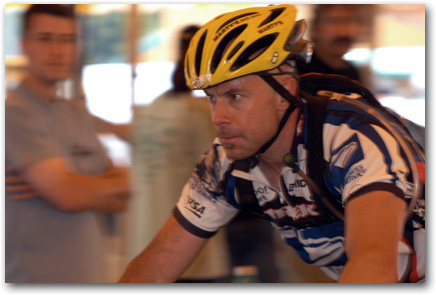
|
|
|
There isn’t much time to take in the view at the top of Highwall, as the trail darts into the woods for a hairy, tree-lined ride down steep singletrack, gnotted with slippery tree roots and the occasional glop of mud. It’s all downhill back to the Silver Creek base area. After 7 exhausting miles, what happens next depends on the class of racer. Many teams, both professional and amateur and in different age classes, include multiple members. When one member completes a lap, a baton is handed to the next racer. But the event is not a relay race for all: a solo class allows individual riders to complete one lap after another, as many as they can through the entire 24 hours.
The 24-hour nature of the event brings its own challenges: racers must compete in varying conditions. Throughout the 24 hours, course conditions can change dramatically. As the course is tracked by more riders, sections can become slippery. At one point in the race, it rained lightly. Bright, warm sun greeted racers during parts of the event, while complete darkness descended upon the course in a foggy, chilly night. Participants had to deal with the potential of equipment failures, make sure light batteries were charged, and even perform minor first-aid on themselves in the race. (Few racers managed to avoid at least a small scrape or bruise; a sudden trip over the handlebars was also not an isolated incident, although no major injuries were reported.)
Many racers had their own network of supporters, with teams of mechanics standing by ready to perform quick tune-ups, and family members waiting eagerly to offer cheers of encouragement.
In fact, spectators play a big role in making the 24 Hours of Snowshoe such an exciting and memorable race: a team of spectators is standing by, 24 hours a day, to cheer on every team as they pass through points of the course.
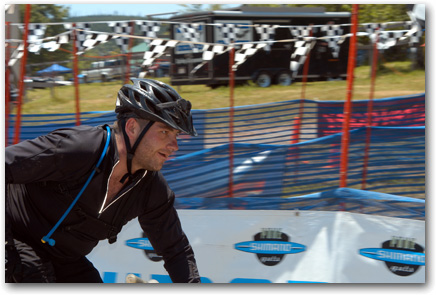
|
|
|
A lady had climbed to the top of Highwall, greeting bikers as they finished an excruciating, lung-burning climb. With enthusiasm that would be frightening in most day-to-day circumstances, she offered hearty words of encouragement to each biker that passed by.
“Come on 11, you’re almost there!” she yelled to one team member.
“Way to go 137, you’re doing great!” she yelled to another.
Her words of encouragement and energy level gave more than one rider the motivation to carry on with renewed vigor.
The 24 Hours of Snowshoe draws racers with varying ability levels. The Coed Pro/Am class, which drew two teams this year, attracts some of the best mountain bikers in the country.
The Trek/VW East Coast team (shown below) took top honors and provided an awe-inspiring performance. The first racer to complete a lap was the team’s Chris Eatough, clocking in with a time of 45 minutes and 20 seconds. The second lap was completed by the team’s Jeremiah Bishop, in just 38 minutes and 35 seconds - what would be the quickest lap by any racer in the course of the event. The Trek/VW East Coast team was able to finish 27 laps, finishing the last lap at 12:01 p.m. on Sunday. (Racers can start new laps anytime up to noon, so racers begin finishing their last lap at noon on Sunday. A team’s final placing is determined by the number of laps completed and the sequential order of finish within the team’s last lap.)
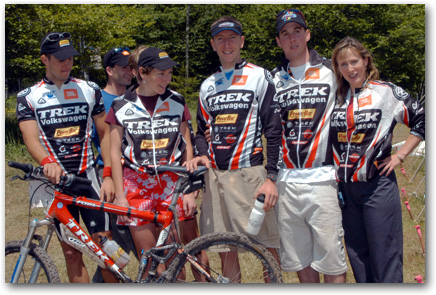
|
|
|
Although pro teams, as expected, turn out the best times, impressive and inspiring performances are turned out by amateur racers in a variety of classes. For example, the Men’s Masters class drew four teams with team members being at least 45 years old. The winning team in this category, Double J’s Disciples, churned out 24 laps, besting many much yonger teams.
While adult racers competed in their 24-hour adventure, kid racers were treated with their own event: the 24 Minutes of Snowshoe. Several dozen children competed in the good-natured races (separated by age class), with a chorus of cheers from camera-wielding parents bringing large smiles to the children’s faces. Children were treated to their own award ceremony.
Following the conclusion of the (adult) race, team mechanics were able to take over the course for their own race. Of course, in the Mechanics’ Wrench race, the bikes didn’t start assembled, so the race centered around who could assemble bikes the quickest.
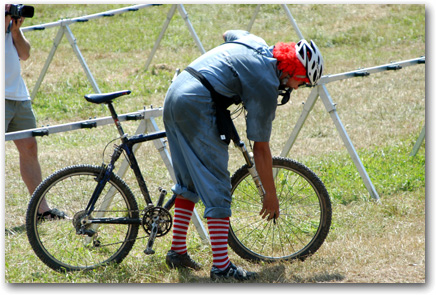
|
|
|
An exhibition was held throughout the race at the Silver Creek base area, with vendors hawking t-shirts and bicycle lighting systems. Tunes from a wide variety of musical genres (including C. W. McCall’s “Convoy,” a classic DCSki’s Editor hadn’t heard since his childhood) were played in the base area throughout the race, while an announcer kept spectators up to date on the latest standings.
Standings were calculated in real-time using a scoring system pioneered by Granny Gear Productions. Racers carried a radio card that was scanned each time they completed a lap. Fed into a computer, real-time scores could be tracked by visitors to Granny Gear’s web site, or by anyone with a WiFi-enabled laptop at the race.
The next event for Granny Gear Productions is the 6th Annual 24 Hours of Tahoe race, to be held August 23 and 24, 2003 at Northstar-at-Tahoe Resort. Following that, the infamous 24 Hours of Moab race will be held in Moab, Utah from October 18-19.
While course conditions vary across these events (from the tree-lined singletrack of Snowshoe to the slickrock and desert terrain of Moab), one thing is common: participants will enjoy 24 extremely challenging hours that are also extremely rewarding.
View additional DCSki coverage of the 2003 24 Hours of Snowshoe and photos in the following sections:
For more information on the race or to view complete results, visit Granny Gear Productions. For more information on Snowshoe Mountain Resort, visit Snowshoe’s website.
All photos were taken by M. Scott Smith.
M. Scott Smith is the founder and Editor of DCSki. Scott loves outdoor activities such as camping, hiking, kayaking, skiing, and mountain biking. He is an avid photographer and writer.

Join the conversation by logging in.
Don't have an account? Create one here.